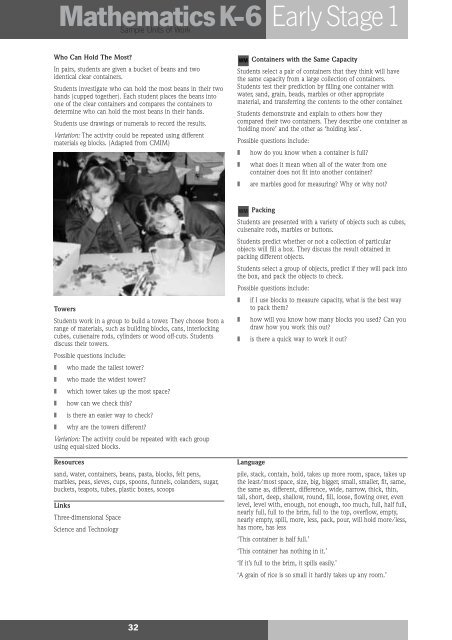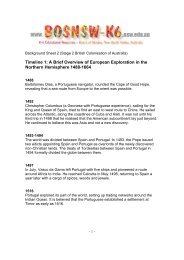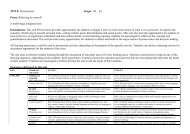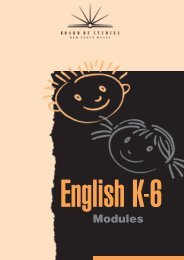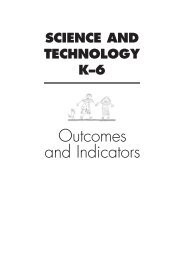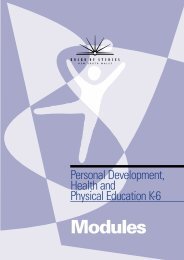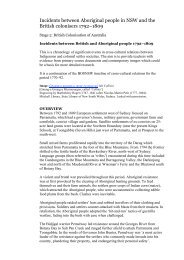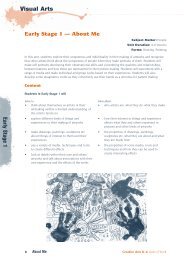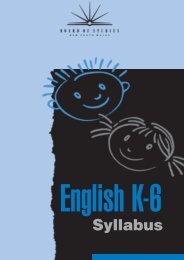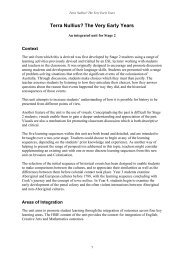Math K-6 WS - K-6 Educational Resources
Math K-6 WS - K-6 Educational Resources
Math K-6 WS - K-6 Educational Resources
Create successful ePaper yourself
Turn your PDF publications into a flip-book with our unique Google optimized e-Paper software.
<strong>Math</strong>ematicsK-6 Early Stage1<br />
Who Can Hold The Most?<br />
In pairs, students are given a bucket of beans and two<br />
identical clear containers.<br />
Students investigate who can hold the most beans in their two<br />
hands (cupped together). Each student places the beans into<br />
one of the clear containers and compares the containers to<br />
determine who can hold the most beans in their hands.<br />
Students use drawings or numerals to record the results.<br />
Variation: The activity could be repeated using different<br />
materials eg blocks. (Adapted from CMIM)<br />
Towers<br />
Students work in a group to build a tower. They choose from a<br />
range of materials, such as building blocks, cans, interlocking<br />
cubes, cuisenaire rods, cylinders or wood off-cuts. Students<br />
discuss their towers.<br />
Possible questions include:<br />
❚ who made the tallest tower?<br />
❚ who made the widest tower?<br />
❚ which tower takes up the most space?<br />
❚ how can we check this?<br />
❚ is there an easier way to check?<br />
❚ why are the towers different?<br />
Variation: The activity could be repeated with each group<br />
using equal-sized blocks.<br />
sand, water, containers, beans, pasta, blocks, felt pens,<br />
marbles, peas, sieves, cups, spoons, funnels, colanders, sugar,<br />
buckets, teapots, tubes, plastic boxes, scoops<br />
Links<br />
Three-dimensional Space<br />
Science and Technology<br />
Sample Units of Work<br />
WM<br />
Containers with the Same Capacity<br />
Students select a pair of containers that they think will have<br />
the same capacity from a large collection of containers.<br />
Students test their prediction by filling one container with<br />
water, sand, grain, beads, marbles or other appropriate<br />
material, and transferring the contents to the other container.<br />
Students demonstrate and explain to others how they<br />
compared their two containers. They describe one container as<br />
‘holding more’ and the other as ‘holding less’.<br />
Possible questions include:<br />
❚ how do you know when a container is full?<br />
❚ what does it mean when all of the water from one<br />
container does not fit into another container?<br />
❚ are marbles good for measuring? Why or why not?<br />
WM<br />
Packing<br />
<strong>Resources</strong> Language<br />
32<br />
Students are presented with a variety of objects such as cubes,<br />
cuisenaire rods, marbles or buttons.<br />
Students predict whether or not a collection of particular<br />
objects will fill a box. They discuss the result obtained in<br />
packing different objects.<br />
Students select a group of objects, predict if they will pack into<br />
the box, and pack the objects to check.<br />
Possible questions include:<br />
❚ if I use blocks to measure capacity, what is the best way<br />
to pack them?<br />
❚ how will you know how many blocks you used? Can you<br />
draw how you work this out?<br />
❚ is there a quick way to work it out?<br />
pile, stack, contain, hold, takes up more room, space, takes up<br />
the least/most space, size, big, bigger, small, smaller, fit, same,<br />
the same as, different, difference, wide, narrow, thick, thin,<br />
tall, short, deep, shallow, round, fill, loose, flowing over, even<br />
level, level with, enough, not enough, too much, full, half full,<br />
nearly full, full to the brim, full to the top, overflow, empty,<br />
nearly empty, spill, more, less, pack, pour, will hold more/less,<br />
has more, has less<br />
‘This container is half full.’<br />
‘This container has nothing in it.’<br />
‘If it’s full to the brim, it spills easily.’<br />
‘A grain of rice is so small it hardly takes up any room.’


